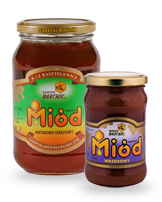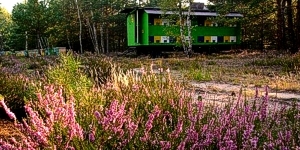|
Beehive of the Millennium Beekeeping Museum |
News
Heather honey under protection of the EU
It has the tea-amber colour (sometimes paler sometimes darker); amber/red-amber colour just before crystallizing; yellow-orange (sometimes even brown) after crystallizing and this is what makes it different from other honeys.
The more natural dyes (carotenoids - mainly beta-carotene and xantophyll, flavonoids and anthocyanins) there are in honey, the darker ii its colour.
Heather honey has the consitency of thick and jellied liquid or gel. It is characterized by semi-granular crystallization. It's not too sweet and its flavour is spicy and bitter. It has strong smell that similar to the smell of heath.
The content of the heather pollen is not lower than 50% . This and even higher parameters, as they reach even 80% of pollen content, are only to be achieved by the beekeepers from the Lower Silesian woodlands, in particular from Przemkowskie Heath that is the protected area by the program 'Nature 200'.
What is more, there can be found flora of Atlantic climate such as cross-leaved heath, brown beaksedge and figwort plants that are not found in any other place in Poland.
First recorded information about beekeeping traditions on in the area of Lower Silesia go back to the 9th century. Later, after the spread of Christianity the beekeeping became the domain of monasteries. In 12th and 13th started to appear first wicker and straw beehives.
According to the German chronicles and ecclesiastical documents, beehives were intensively exploited in the area between the Oder and Leba rivers, what is especially proved by the fact that the Slavic people paid tribute to use the woodlands for the purpose of beekeeping. It was customary to pay in honey pots and one pot corresponded to one surface unit. Some beekeepers had to pay even up to 100 pot what perfectly shows how extensive and profitable was this branch of agriculture.
The sources also states that the majority of beekeepers lived in the urban area of Zgorzelec and Zgorzelecko-Osiecznicka forests. As a result, this region was famous for honey fairs and beekeeping associations directed by the chieftains. What is even more interesting, beekeepers had also their own local courts.Oddly enough, Lower Silesian woodlands owe their widely known heath to the military. In 1898 the owners of the woodlands - the family of Dohnowie - donated the land of Swietoszowo ( today approximately 5700-8500 ha) for the military range. During the tree felling work in 1900 fire occurred that completely destroyed the tree stand. And this is how the heaths appeared.
From the 19th century, the German people, living in this region, exploited the land especially in the seasons of heath blooming. After 1945, the expatriates from the east part of the country returned and continued to cherish the beekeeping traditions.
Heather honey is currently produced in Lower Silesia by around 500 beekeepers. Last year, thanks to the favourable weather conditions they were able to produce almost 300 000 tons. The results from previous years oscillated around the level of 2 000 per year
The beekeepers hope that the EU certificate will contribute to the considerable of popularization of their heather honey that would eventually lead to the increase in demand.
Source: www.potrawyregionalne.pl
'Sadecki Bartnik' congratulates the Lower Silesian beekeepers on their receiving the EU emblem of Protected Geographical Indicator.
The more natural dyes (carotenoids - mainly beta-carotene and xantophyll, flavonoids and anthocyanins) there are in honey, the darker ii its colour.
Heather honey has the consitency of thick and jellied liquid or gel. It is characterized by semi-granular crystallization. It's not too sweet and its flavour is spicy and bitter. It has strong smell that similar to the smell of heath.
The content of the heather pollen is not lower than 50% . This and even higher parameters, as they reach even 80% of pollen content, are only to be achieved by the beekeepers from the Lower Silesian woodlands, in particular from Przemkowskie Heath that is the protected area by the program 'Nature 200'.
What is more, there can be found flora of Atlantic climate such as cross-leaved heath, brown beaksedge and figwort plants that are not found in any other place in Poland.
First recorded information about beekeeping traditions on in the area of Lower Silesia go back to the 9th century. Later, after the spread of Christianity the beekeeping became the domain of monasteries. In 12th and 13th started to appear first wicker and straw beehives.
According to the German chronicles and ecclesiastical documents, beehives were intensively exploited in the area between the Oder and Leba rivers, what is especially proved by the fact that the Slavic people paid tribute to use the woodlands for the purpose of beekeeping. It was customary to pay in honey pots and one pot corresponded to one surface unit. Some beekeepers had to pay even up to 100 pot what perfectly shows how extensive and profitable was this branch of agriculture.
The sources also states that the majority of beekeepers lived in the urban area of Zgorzelec and Zgorzelecko-Osiecznicka forests. As a result, this region was famous for honey fairs and beekeeping associations directed by the chieftains. What is even more interesting, beekeepers had also their own local courts.Oddly enough, Lower Silesian woodlands owe their widely known heath to the military. In 1898 the owners of the woodlands - the family of Dohnowie - donated the land of Swietoszowo ( today approximately 5700-8500 ha) for the military range. During the tree felling work in 1900 fire occurred that completely destroyed the tree stand. And this is how the heaths appeared.
From the 19th century, the German people, living in this region, exploited the land especially in the seasons of heath blooming. After 1945, the expatriates from the east part of the country returned and continued to cherish the beekeeping traditions.
Heather honey is currently produced in Lower Silesia by around 500 beekeepers. Last year, thanks to the favourable weather conditions they were able to produce almost 300 000 tons. The results from previous years oscillated around the level of 2 000 per year
The beekeepers hope that the EU certificate will contribute to the considerable of popularization of their heather honey that would eventually lead to the increase in demand.
Source: www.potrawyregionalne.pl
'Sadecki Bartnik' congratulates the Lower Silesian beekeepers on their receiving the EU emblem of Protected Geographical Indicator.
Copyright © 1997-2024 Gospodarstwo Pasieczne "Sądecki Bartnik" sp. z o.o. (dawniej Gospodarstwo Pasieczne "Sądecki Bartnik" Janusz Kasztelewicz)







